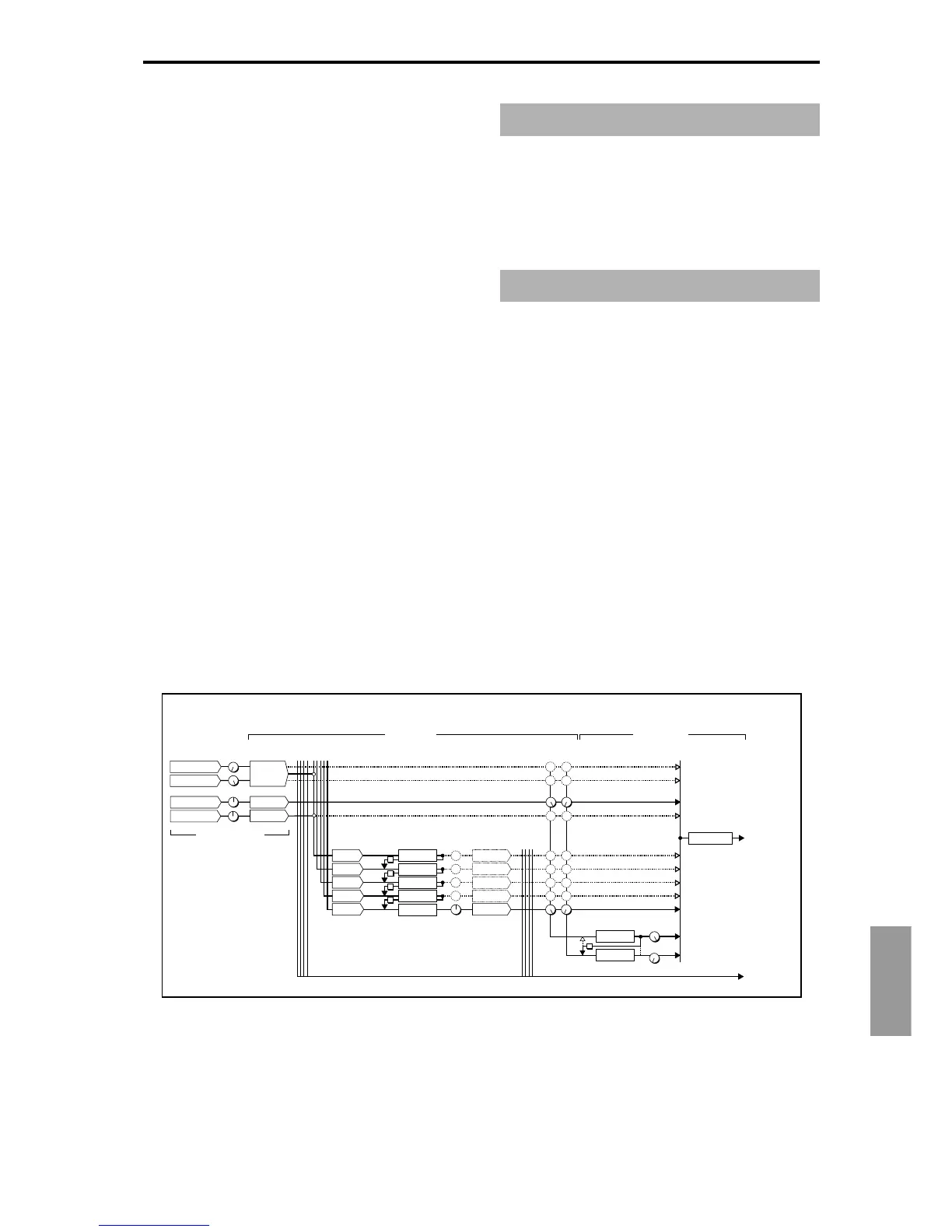Effect
153
3–5. Chain Level
This parameter determines the level of signals routed from
one MFX to the other MFX in a chain connection.
3–6. Master EQ Gain [dB]
These parameters are used to set the gain of the Low, Mid,
and High stereo three-band EQ that is located right before
AUDIO OUTPUT (MAIN) L/Mono and R. Low and High
EQs are of the shelving type, and Mid EQ is a band type
equalizer. These slider settings are linked with the Low, Mid,
and High “Gain [dB]” parameters of the “MasterEQ” tab.
Use this “MasterEQ” tab to set the center frequency, band
width (for Mid), and dynamic modulation of the EQ bands.
4. Controlling the Master Effects via
MIDI
You can use the Dynamic Modulation (Dmod) function to
control all Master Effects parameters in real-time from the
TRITON’s controllers or from an external MIDI sequencer.
In Program mode, the parameters are controlled on MIDI
Global channel “MIDI Channel” (Global P1: 1–1a).
In Combination mode, Sequencer mode, and Song Play
mode, you can set the control channels for MFX1 and MFX2
using the “Ctrl Ch” parameters of the “MFX1–2” tabs. Select
the desired option from Ch01–16, and Gch.
Ch01–16: Select this option if you wish to control the param-
eters for each Master Effect on different channels.
Gch: Select this option if you wish to control the parameters
on MIDI Global channel “MIDI Channel” (Global P1: 1–1a).
This is the normal setting.
The Master EQ (stereo, three-band EQ) is located right
before AUDIO OUTPUT (MAIN) L/MONO, R. Low and
High EQs are of the shelving type, and Mid EQ is a peaking
type equalizer. You can control the Low Gain and High Gain
parameters using the Dynamic Modulation function.
The Master EQ is applied to the signal input from the L/R
bus. For more information on the parameters,
☞p.207.
The TRITON is equipped with four individual AUDIO
OUTPUTs (INDIVIDUALs). You can route the oscillator
(Program), timbre (Combination), and track (Sequencer)
output or the post-IFX signals to these four individual out-
puts.
Use “BUS Select” of the P8: “Routing” tab in Program, Com-
bination, Sequencer, or Song Play mode to route the oscilla-
tors (Program), timbres (Combination), or tracks (Sequencer,
Song Play) to AUDIO OUTPUTs (INDIVIDUAL). If you are
using the Insert Effects, use “BUS Select” of the P8: “Insert
FX” tab to route the post-IFX signals.
1, 2, 3, 4: Monaural signals are routed to AUDIO OUTPUTs
(INDIVIDUAL).
1/2, 3/4: Stereo signals are routed to AUDIO OUTPUTs
(INDIVIDUAL). Use AUDIO OUTPUTs (INDIVIDUAL) 1/2
in stereo for 1/2, and use AUDIO OUTPUTS (INDIVID-
UAL) 3/4 in stereo for 3/4.
Program mode
Master EQ
Individual Outputs
Pan
Oscillator 1
Send1
Select from:
L/R
IFX1
IFX2
IFX3
IFX4
IFX5
1
2
3
4
1/2
3/4
Off
IFX2 BUS
IFX2
IFX1 BUS
IFX1
Chain
✓
MFX2
MFX1
mono
mono
Return1 / 2
Master EQ
AUDIO OUTPUT
(MAIN) L/Mono, R
IFX4 BUS
IFX4
IFX3 BUS
IFX3
IFX5 BUS
IFX5
BUS Select
= L/R
Oscillator 2
IFX / Indiv.Out
BUS Select
stereo
Insert Effects
Post IFX
Pan(CC#8)
BUS Select
Select from:
L/R
1
2
3
4
1/2
3/4
Off
Send2
stereo
Master Effects
AUDIO OUTPUT
(INDIVIDUAL)1/2/3/4
L/R BUS
stereo
mono x 4mono x 4
BUS Select
= IFX1
stereo
stereo
stereo
stereo
stereo
Chain
Effect / Mixer Block Diagram in Program Mode
P8: Insert Effect
Post IFX
Send1 / 2
P9: Master Effect
✓
✓
✓
AUDIO INPUT 1
AUDIO INPUT 2
BUS Select
= L/R
BUS Select
= IFX1
Global P0: Audio Input
(AUDIO INPUT1,2)
Global P0: Audio Input
(Send1,2 on AUDIO INPUT1, 2)

